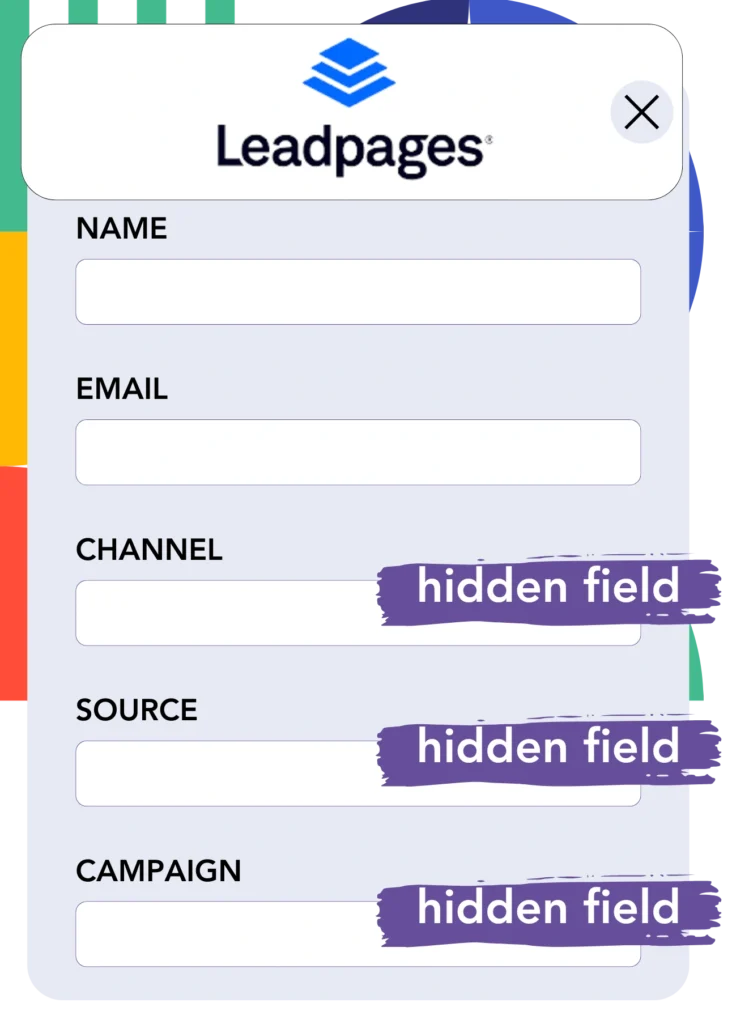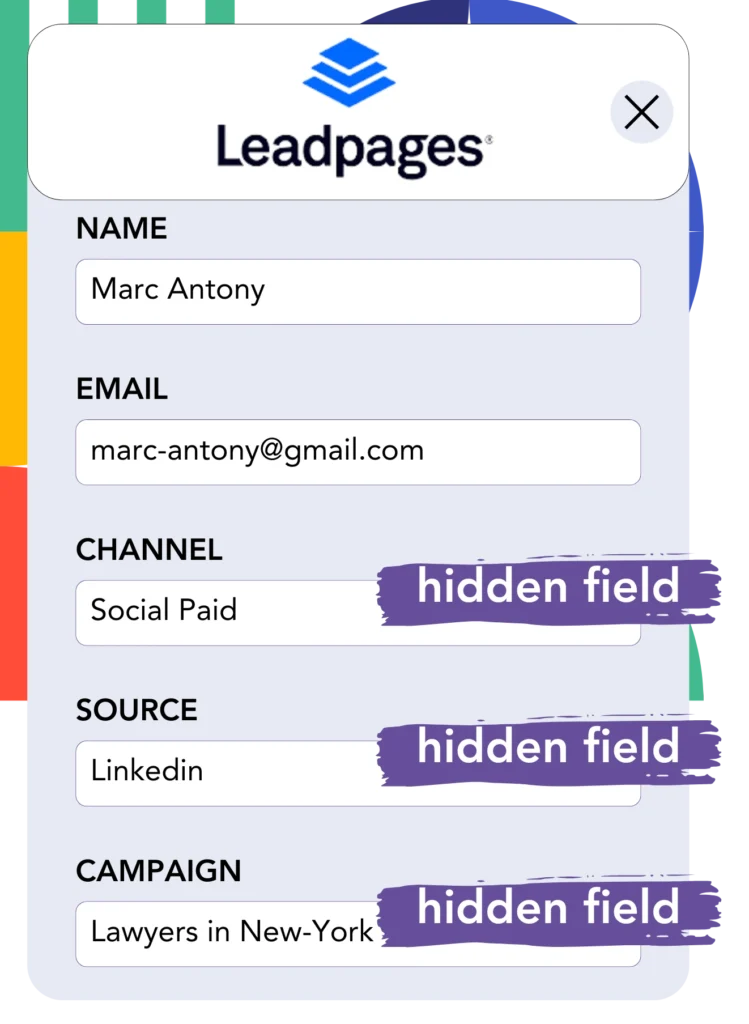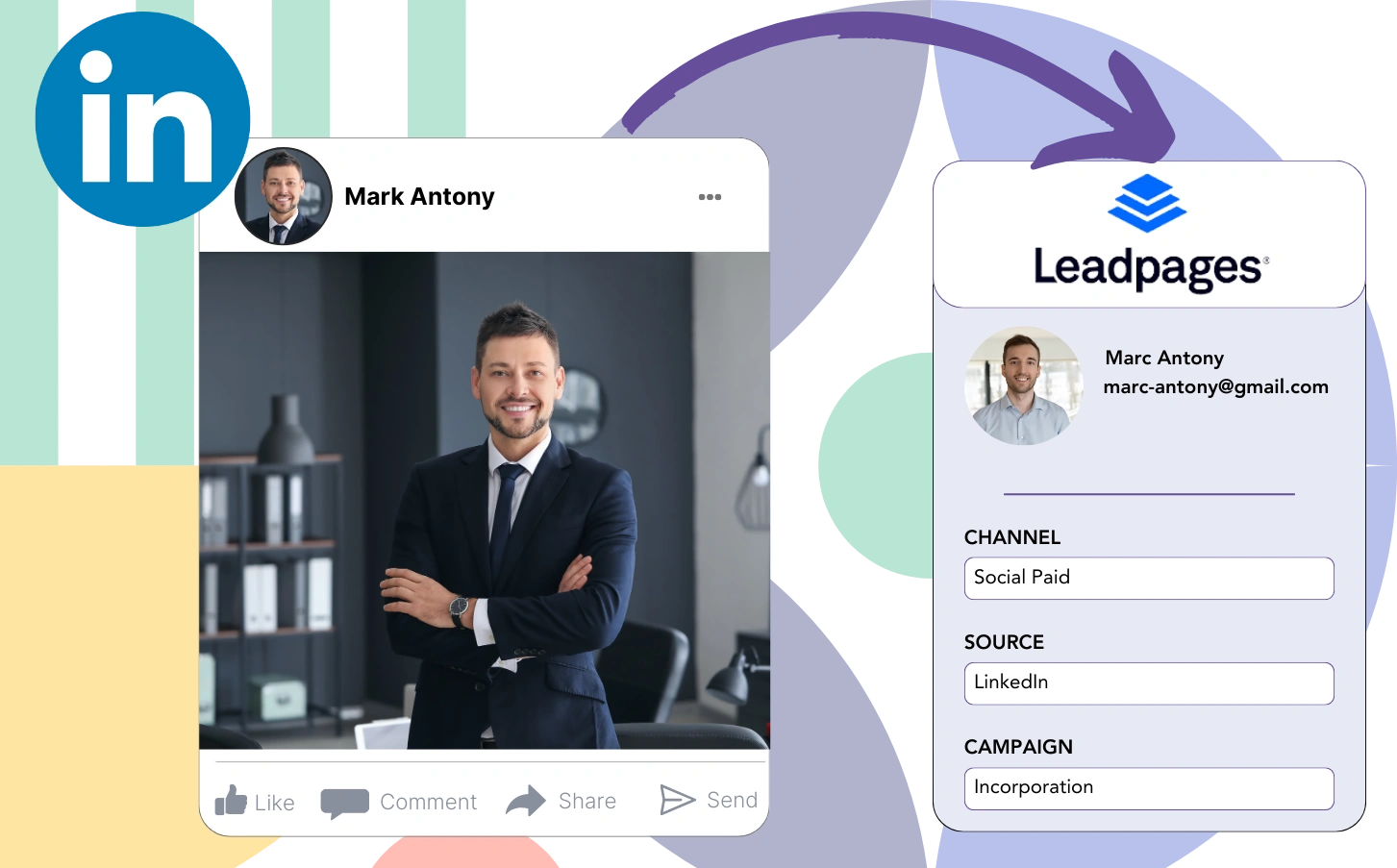Maximizing LinkedIn advertising performance requires knowing which ad is effectively generating your leads, sales, and revenue.
The total number of leads from your LinkedIn ads is likely known, but the breakdown at the individual lead level remains hard to define.
This leaves you uncertain about which LinkedIn ad generated the leads that became customers, making it challenging to optimize your budget.
Leadsources offers a clear solution to this issue.
With Leadsources, you can capture LinkedIn ads data, such as campaign, audience, ad, etc., all the way down to the lead level.
Storing LinkedIn ad data, such as campaign, audience, and ad details, for every lead is possible in Leadpages.
You can create reports, such as “Ads that generated the most leads,” to make informed decisions on which ads to promote or discontinue.
Let’s dive into it!
Capture LinkedIn ads in Leadpages
Step 1: Add Leadsources in the head tag of your website

Sign up to Leadsources.io, and benefit from our 14-day free trial.
Include the Leadsources tracking code within the head tag of your site.
No code is necessary, follow this easy step-by-step guide.
Step 2: Add the UTM parameters to your LinkedIn campaigns

Configure the UTM parameters you want to track within each of your LinkedIn ads, including campaign, audience, ad, etc.
As an illustration, consider including these UTM parameters to the links in your LinkedIn ads:
- UTM_source
- UTM_campaign
- UTM_term
- UTM_content
Take into account that Leadsources captures lead source data without UTM parameters, such as channel, landing page, and landing page subfolder, allowing for a comprehensive understanding of your leads.
Step 3: Add the hidden fields in Leadpages

When an individual completes your Leadpages form, Leadsources automatically fills in the hidden fields with the necessary LinkedIn ads data, such as campaign, audience, ad, etc.
Implement the steps outlined in our guide to add hidden fields in Leadpages and ensure your setup is complete.
The LinkedIn ads data is then securely stored in your Leadpages form by Leadsources (consult Step 4 for specifics).
Step 4: Capture the LinkedIn ads data in Leadpages

When a visitor engages with your LinkedIn ad, Leadsources records LinkedIn ad data (campaign, ad set, audience, ad, etc.) as they navigate to your website.
The hidden fields in your Leadpages form automatically get data from LinkedIn ads thanks to Leadsources.
Upon the form’s submission, the LinkedIn ads data is forwarded along with the responses to the Leadpages submissions page for each lead created.
How does Leadsources work?
The inclusion of the Leadsources tracking code in the head tag of your site permits the capture of LinkedIn ads data (campaign, audience, ad, etc.) each time a visitor accesses your website.
The hidden fields of your Leadpages form are utilized to retain the LinkedIn ads data after it has been collected.
The following categories of visitor data will be captured by Leadsources:
- Channel
- Source
- Campaign
- Content
- Term
- Landing page
- Landing page subfolder
This capability allows you to retain visibility over key lead source details, even when UTM parameters are ineffective, especially when traffic is derived from organic sources such as:
- Google Search
- Instagram bio link
- Social media posts
- Etc.
Most tools require UTM parameters for lead data collection, but Leadsources offers effective tracking of your lead source without the need for them.
As such, unlike other tools, Leadsources tracks lead data from all channels:
- Organic Search
- Paid Search
- Organic Social
- Paid Social
- Referral
- Affiliate
- Display Advertising
- Direct Traffic
This makes it easier for you to track and centralize all lead source data in one place.
Pro tip:
Track LinkedIn ads in your favorite online form builder, including Cognito Forms, Gravity Forms, Jotform, Typeform, or WPForms. Using another online form builder? Check our guide on how to track LinkedIn ads in your form.
How to run performance reports
Since your LinkedIn ads data is saved in Leadpages, you can produce performance reports such as:
- Leads per campaign
- Leads per Ad set
- Leads per audience
- Leads per ad
- Etc.
This enables you to make wiser decisions about your LinkedIn budget.
Let’s investigate the various forms of reports you are able to produce.
1. Lead performance reports
Reports can be prepared to show the volume of leads acquired from:
- Channel
- Campaign
- Ad set
- Audience
- Ad
- Landing page
- Landing page subfolder
Example #1
You can export data from campaigns in several channels (SEO, Social Paid, Email, etc.) and create a report referred to as “Leads by Channel.”

Example #2
After establishing the top-performing channel (e.g., LinkedIn ads), you can focus on it to view the leads generated by each specific campaign.

Example #3
However, after you identify the campaign with the highest number of leads, you can investigate which particular LinkedIn audience, campaign, or ad is responsible for them.

2. Sales performance report
Finding the best LinkedIn ads and target audiences can improve your lead generation. But how can you make sure these actions match your sales goals and revenue targets?
Looking at lead performance in a CRM like GoHighLevel shows how well customers are converting. This information helps you create sales reports based on your LinkedIn ads data, including details about the campaign, ad, and audience.
Check on this example:
| Channels | Search Paid | Social Paid |
| Leads | 50 | 75 |
| Sales | 5 | 6 |
| Average order value | $150 | $100 |
| Revenue | $750 | $600 |
As indicated in the “Leads by Channel” report, the performance of Social Paid ads on LinkedIn surpassed that of Search Paid ads, resulting in a notable increase in lead generation.
The review of your sales performance data from the CRM export revealed that, although the Search Paid channel attracted fewer leads, it generated a significantly higher revenue, suggesting that increasing the Search Paid budget could be beneficial for overall performance.
You have the option to analyze trends over time in both sales and revenue reports:
- Sales and revenue by source
- Sales and revenue by campaign
- Sales and revenue by content (aka. ad)
- Sales and revenue by term (aka. audience)
- Sales and revenue by landing page
- Sales and revenue by landing page subfolder
LeadSources tracks the source of each lead in Leadpages, whether they come from ads, organic search, social, email, etc. and syncs that data with each submission. See the full breakdown on the lead source in Leadpages page.

